Part 2: The Dawsons of Ardee
by LD Murray, 1933
The family of Dawson settled in Armagh in the reign of James I, and gave their name to a street in the Primatial City. Some of them were officers in the Parliamentary army and were rewarded with grants of land in Co Monaghan. Alderman Richard Dawson, father of the purchaser of the Ardee estate, was a prominent banker in Dublin. We have read somewhere that Dawson Street, Dublin, was named after him and that he built the Mansion House. The appended genealogical tree has been compiled from such documents and records as are available, but we are not quite satisfied as to the accuracy of the portion which deals with the Riverstown branch of the family.

Richard Dawson of Ardee
We have seen that Richard Dawson bought the Ardee property from Philip Tisdall in 1742. In 1754 he rounded off his new estate by leasing from Robert Parkinson – who held Cappock’s Green by lease for ever from the Ardee Corporation at 5/- per annum – 2 acres of land adjoining Dawson’s Avenue along with the portion of Cappock’s Green that lay within the walls of Dawson’s Garden or upon which the wall stood, at a yearly rent of 10/-. In 1758 on the occasion of the marriage of his youngest son, Richard Dawson, junior, to Anne, daughter of Sir Edward O’Brien of Drumgooland, the Ardee property was given as a marriage settlement. Richard Dawson, senior, died in 1766 and was succeeded in the Monaghan estates by his eldest living son, Thomas afterwards Baron Dartry and Lord Cremorne, and in the Ardee estate by Richard, junior.
Richard Dawson (Junior)
The new owner, unlike his elder brother Thomas, who was a strong supporter of the British government and who was raised to the peerage in 1770, took his stand with the people and followed Grattan in politics. Neither Burke’s peerage nor any of the standard works on Genealogy mention the fact that “ he was waylaid and robbed on his way home from the house of a friend on Sunday, March 10th, 1782, and beaten so violently that he died of his woulds. “ the outrage evidently caused a wave of indignation through the whole country. Recently, as a result of one of these slices of luck which too rarely fall to the lot of the historical student, we unexpectedly came on two proclamations dealing with this outrage – one from the Lord Lieutenant and the other from the Louth Grand Jury:
Proclamation I by the Lord Lieutenant and Council of Ireland. Carlisle:
Whereas we have received information on Oath that on Sunday, the 10th day of March 1782, as Richard Dawson, late of Atherdee in Co Louth was returning from the house of a friend of his between 8 and 9 o’clock, in the evening of the aforesaid day, he was waylaid by two or more Ruffians by whom he was feloniously robbed and so violently assaulted that he soon after died of the wounds that he received by the said ruffians or some of them.
Now we the Lord Lieutenant and Council, having a just abhorrence of such barbarous crimes and being determined as far as in us lies, to bring the perpetraitor or perpetraitos to the said robbery and inhuman murder to speedy and condign punishment, do by this our Proclamation publish and declare that if any person or persons committed the said horrid Murder and Robbery so as such Person or Persons may be apprehended and prosecuted to Conviction, the person or persons making such Discovery as aforesaid shall receive as a reward the sum of two hundred pounds.
And we do hereby further publish and declare that if any person or persons privy to or concerned in the said robbery or murder (except the person or persons who gave the wounds of which the said Richard Dawson died) shall on or before said 25th September discover his or her accomplice or accomplices who were guilty of the said murder or robbery so that he or they be apprehended prosecuted and convicted, that such person or persons shall not only receive the said sum of £200 but also His Majesty’s most gracious Pardon for the said offence or offences.
And we do duly charge and command all Justices of the Peace, Mayors, Sheriffs, Bailiffs and others his Majesty’s loving subjects to use their utmost diligence in discovering, apprehending and prosecuting to conviction the several persons or any of them in the said murder or robbery – Given at the Council Chamber in Dublin: 25 May 1782
Proclamation II by the Louth Grand Jury
Whereas Richard Dawson of Ardee in the County of Louth was, on Sunday night, the tenth instant, barbarously attacked, robbed and severely wounded by two persons as yet undiscovered who lay in wait for him within his own gate in the said town of Ardee.
Now, We, the High Sheriff and Grand Jury of the said County of Lowth, having a just abhorrence of such atrocious crimes, do, hereby, offer a reward of one hundred pounds to the person who shall discover and prosecute to conviction both or either of the persons concerned in the said assault, robbery and abuses of the said Richard Dawson, as beforementioned.
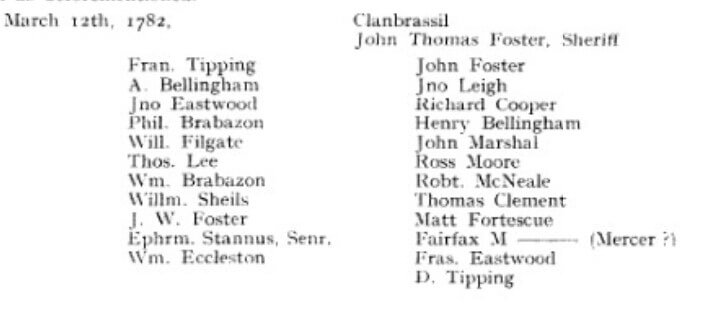
In spite of these rewards there was no evidence that the criminals were ever brought to justice. The late Mr Dolan, in an article which he wrote in one of the local papers about ten years ago, said that the tradition of the country people was that “ the attack was made by some protestant workmen to prevent Dawson from assisting some Catholics who were being returned for trial. “ The Dawson family left Ardee soon afterwards, and went to reside in the Co Monaghan estate.
The MacGauley Lease
In 1784, Richard Dawson, son of the murdered proprietor, granted a lease which led to interminable lawsuits, the final settlement of which was reached only in 1822. For the yearly rent of £146 17s 6d, he devised – to John O’Donnell, shopkeeper of Ardee, Bartholomew MacGauley of Harold’s Cross, Dublin and Patrick Osbourne, farmer – 58 acres and 3 roods of the demesne to hold for 999 years. Osburne died before the parties made a settlement and his proportion became vested in the two survivors. Later on, MacGauley purchased O’Donnell’s interest for £90, but the latter became a bankrupt before the deed was completed. By the year 1799, MacGauley himself had to seek the protection of the bankruptcy court: Patrick Byrne of the City of Dublin was declared legal assignee; and the estate was put up for auction in the Tholsel at Drogheda. Thomas Pepper of Cookstown, the highest bidder, was declared the purchaser for a sum of £1430.
The Peppers of Cookstown
The matrimonial relationships of the Peppers, Dawsons, Metcalfes, and Lelands are difficult to follow – but we record those items which seem fairly clear. Thomas Pepper (senior) of Cookstown, who made his will in 1769 had one son Thomas, and three daughters, Anne, Elizabeth and Sarah. Elizabeth died unmarried about the year 1802; Sarah married John Dawson of Dublin, a distant relative of the head landlord of Dawson’s Demesne and was the mother of the famous Alexander Dawson who became MP for Louth in 1826; while Anne married Henry Metcalfe of Drogheda. The following table is the best that we can make out from the various deeds and wills at our disposal.

Thomas Pepper (senior) by his will dated 1769, divided his property in Cookstown and Rahanna between his three daughters, Ann, Elizabeth and Sarah: and made John Dawson of Castle Street, Dublin (Sarah’s husband) his executor. John Dawson bought the shares of Anne and Elizabeth, and came to live at Cookstown ) about two miles north of Ardee, near the mearing of Cookstown and Rahanna – the house now occupied by the Breen family). Anne Pepper married Henry Metcalfe and went to live in /Drogheda: while Elizabeth stayed on at Cookstown, husbanded her money, and had a considerable sum to her credit at the time of her death in 1804.
Thomas Pepper (junior) of Cookstown, who had bought the MacGauley interest in Dawson’s Demesne in 1799, soon ran short of money. In 1810 he mortgaged the property (Dawson’s Demesne) to Bryan Carroll of Cookstown for £1000 from George Metcalfe of Drogheda – joining his lands at Lisrenny to those of Dawson’s Demesne for security. George Metcalfe died intestate in 1817 and Henry Metcalfe (Pepper’s brother-in-law) to whom administration was granted, filed a bill to foreclose the mortgage. The report of the Master in Chancery showed that £1270 13s 10d principal and interest was due to Bryan Carroll and £1408 1s 11d due to Metcalfe. It was decided in 1821 to sell the lands and premises and pay off the debts. The highest bidder, Bryan Carroll of Cookstown, secured the lands for £1450. In the following year, his brother, Patrick Carroll, assigned all his rights to Alexander Dawson of Riverstown, and stated that he had bought it for Dawson with Dawson’s money. As Dawson was Pepper’s nephew, and Metcalfe was his brother-in-law, it would seem to have been a family transaction with Carroll as an intermediary. Metcalfe must have lost a considerable sum, but his indebtedness was not lost sight of. As we shall see, further on, Alexander Dawson left portion of his estate in trust for Edward Leland, one of Metcalfe’s grandchildren.
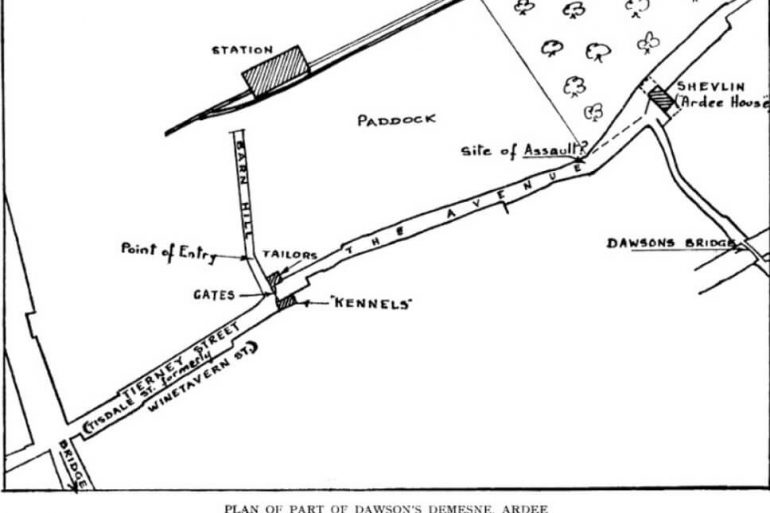
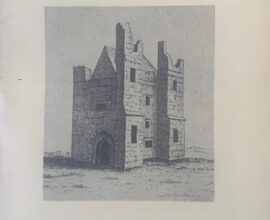
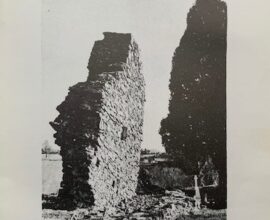
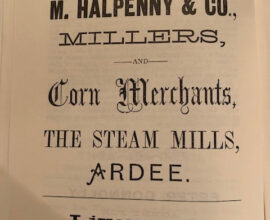
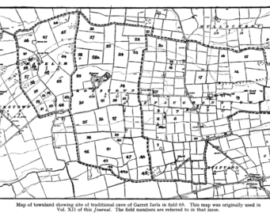
Brilliant & very interesting